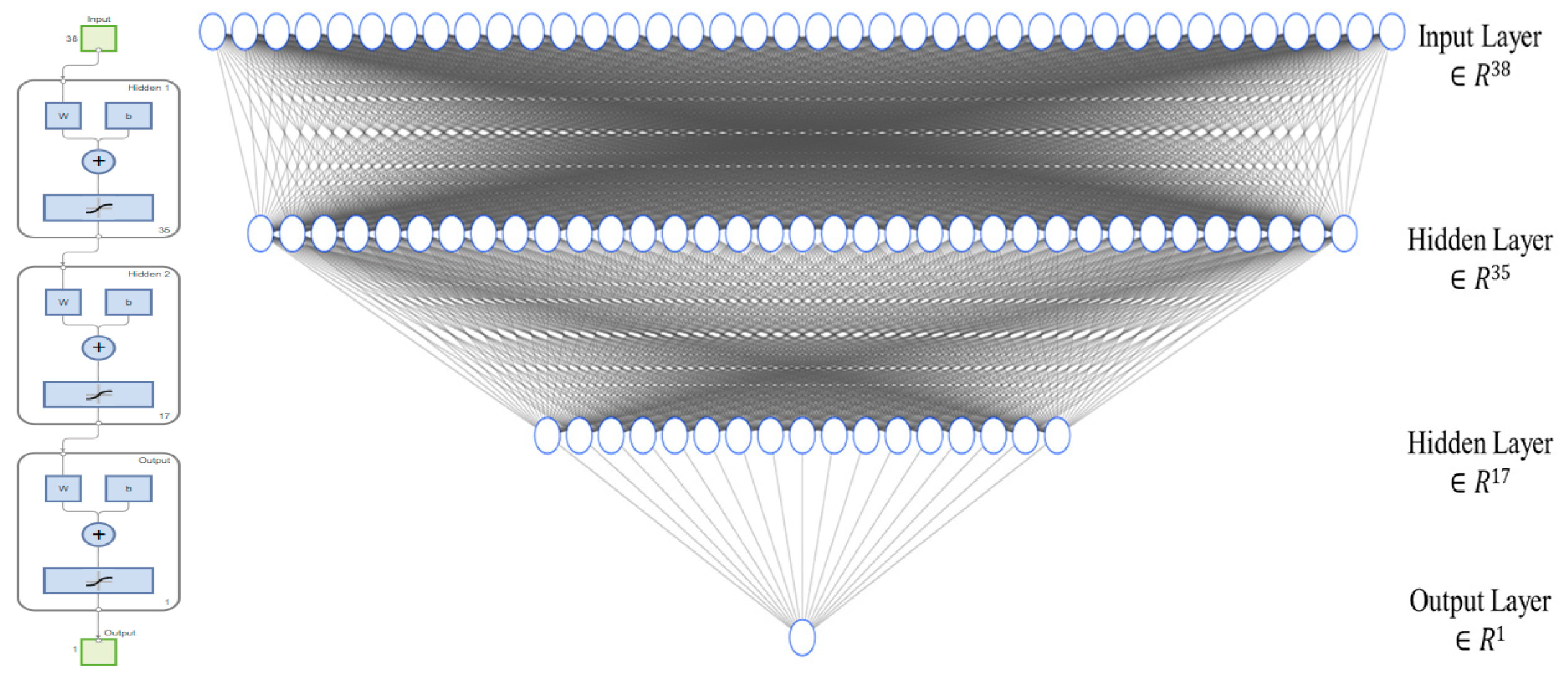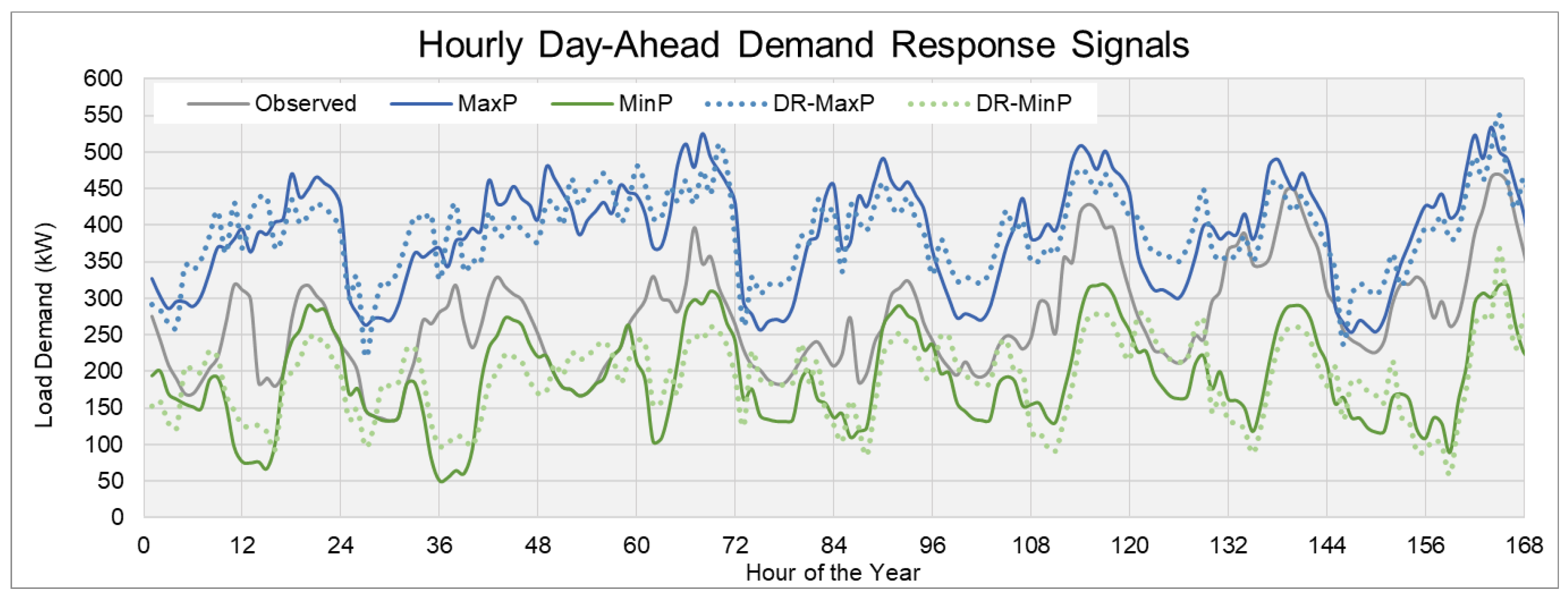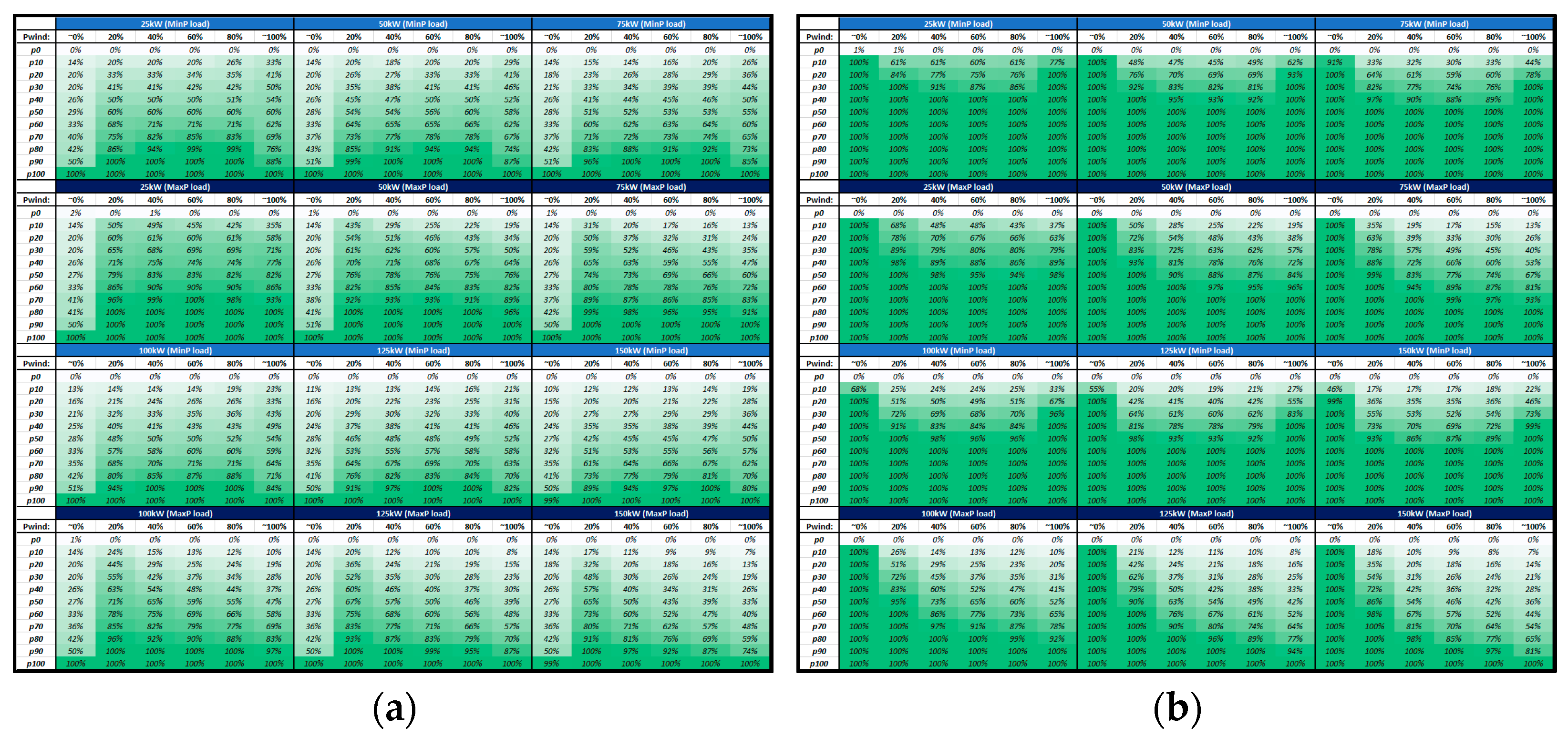1. Introduction
Occurrence of wind energy curtailments in non-interconnected island systems of considerable wind power capacity comes as a result of local grid limitations and significant load variation across seasons [
1]. The problem deteriorates during the winter months, when load demand reduces substantially [
2], but is also notable throughout the year over late-night hours and off-peak periods. Facilitating increased wind energy generation requires flexibility means such as energy storage and/or demand response (DR) [
3], with the latter presenting the advantage of a non-capital-intensive solution. On the other hand, DR requires engagement of loads at the end-user side, which often introduces limitations relating to the operational patterns of loads and the associated level of elasticity. This becomes critical in non-interconnected island systems, where the largest part of electricity consumption falls under the categories of residential customers and hotels, especially during the summer period. At the same time, however, the potential of the DR extends to community-level loads, such as water pumps and/or public e-mobility. This potential, which still remains untapped, offers greater levels of elasticity, which is supported also by the fact that the given pool of loads incorporates water (tanks/reservoirs) and energy (EV batteries) storage components, respectively. Meanwhile, progress encountered in the field of artificial intelligence is nowadays allowing for the development of both effective and reliable forecasting techniques, which may in turn enable the adoption of smart energy management features for the operation of similar island systems [
4,
5].
Acknowledging the above, the current study focuses on addressing the issue of excessive wind energy generation through the development of a stochastic analysis framework that makes use of ANN-based signals and the assumption of different levels of DR potential, with the problem formulated in the context of day-ahead dispatch scheduling for the operation of non-interconnected island systems. To that end, in the following
Section 2 of the paper, we present the relevant input data and provide the problem definition and methods. Accordingly, in
Section 3, we provide a set of preliminary results of our research and proceed further with their discussion under
Section 4, while
Section 5 provides the main conclusions of our research.
2. Materials and Methods
2.1. Problem Definition and Methods
For the purpose of our analysis, we use the Aegean Archipelagos as the study area and apply our methodology to the non-interconnected island system of Kos and Kalymnos, focusing on the island of Tilos. The broader Kos and Kalymnos system, found in the SE region of the Aegean Sea, comprises nine islands, including the island of Tilos. The overall system features a peak demand of ~105 MW and an annual consumption of ~360 GWh and hosts a total of four wind parks. These are determined by a total capacity of 15.2 MW and, owing to the limited flexibility locally, face energy curtailments that even exceed 25% of the respective theoretical energy yield on an annual basis [
1]. At the same, Tilos presents an annual electricity demand in the order of ~3 GWh, and a peak demand slightly lower than 1 MW, with a considerable part of the local electricity consumption attributed to public loads, like water pumping and a small EV fleet. In this context, the Kos and Kalymnos system is seen as the “market”, while Tilos is treated as a microgrid entity that interfaces the market, offering aggregate DR services for the recovery of wind energy curtailments at the market level.
A schematic block of the proposed framework is provided in
Figure 1, under which, with the use of artificial neural networks and historical data of wind energy generation (theoretical and actual) for the Kos–Kalymnos system, estimation of day-ahead wind energy curtailments is first attempted, with relevant results currently adopted from a previous study of the authors [
6]. At the same time, using historical load demand data from the island of Tilos [
5], we develop a similar ANN model for the day-ahead prediction of load demand locally. Based on these two components and assuming load pools of different DR capacity, we next assess the day-ahead demand response requirements on the island of Tilos, and we apply a stochastic approach, which allows for the incorporation of forecasting uncertainties in our analysis.
2.2. Input Data
As already mentioned, day-ahead predictions of the theoretical and actual wind power generation on an hourly basis are currently adopted from a previous study of the authors [
6], where the first two ANN models of
Table 1 were evaluated as optimal amongst a broader set of models developed (see also
Figure 2). The given models provide prediction of the day-ahead, both actual and theoretical, hourly wind power capacity factor (CF) for the electricity system of Kos and Kalymnos, which may in turn allow estimation of the respective wind energy curtailments anticipated in the given system. Moreover, and in the context of the present study, an additional day-ahead ANN model has been developed for the prediction of hourly load demand, for the island of Tilos (
Table 1).
With regard to the development of the models, including also the one of load demand, training input (historical data of wind power generation and load demand, respectively) draws data from the previous five days (D-1, D-2, D-3, D-4, and D-5), with the aim to provide a total of 24 distinct hourly predictions for the day-ahead (D+1). In that way, the required input for the models’ execution becomes independent of day (D-0) data. As a result, and in the context of a rolling day-ahead scheduling pattern, increased flexibility is provided concerning the execution time of the models during the previous day (D-0). This was considered to be one of the main development principles of the models, which also allows for the incorporation of new rolling historical data of each (D-1) day, normally cleared and published every other (D-0) day (i.e., one day after). A reasonable assumption to that end is that the models are executed at 12:00 of day (D-0), allowing for the incorporation of (D-1) data on the one hand and for the delivery of forecasting results in time for the prompt release of the day-ahead dispatching schedule on the other.
Based on the results of the three models and associated uncertainties (forecasting residuals), the problem is next formulated as a stochastic analysis problem, with the aim to map DR requirements under different levels of probability and also available levels of assumed DR capacity. To that end, the available DR capacity for the case of Tilos is set to vary from a minimum of 25 kW to a max of 150 kW, which is below the minimum load demand encountered during the year and which may reflect on the engagement of ~70 kW of the community-level water pumping capacity, as well as on a prospective 80 kW of the charging capacity for the local e-mobility sector.
3. Results
The first set of results given in the following
Figure 3 provide a two-week instance of the theoretical and actual wind energy production expressed in terms of hourly CF for the aggregate power of 15.2 MW for all four existing wind parks of the Kos–Kalymnos system. Prediction curves included incorporate the maximum and minimum uncertainty associated with different CF classes and day hours, providing, as it may be seen, a relatively wide span of probability that is set to capture the entire range of residuals [
6]. Based on the day-ahead hourly forecasts, the respective estimated output concerning the hourly day-ahead estimation of wind energy curtailments is given in
Figure 4a for a set of different percentile curves compared against the series of observed wind energy curtailments. As one may note, for percentiles exceeding 20–30%, there is significant overestimation of wind energy curtailments, which is mainly owed to the relatively limited performance of the actual wind power CF forecasting model.
Accordingly, by also integrating forecasting results of load demand (
Figure 4b), and by introducing a daily cycle DR scheme, we proceed with a stochastic analysis of daily DR requirements, taking also into account a variable DR capacity. The stochastic application of the daily cycle DR scheme is illustrated in the following
Figure 5, for an instance of a 50 kW DR pool and the ~100th percentile of wind forecasting results addressed earlier, against the minimum and maximum probability of load demand. As it can be seen from both load curve instances, the dotted DR-adjusted curves, follow the pattern of the original load demand curves, deviating however at a certain level, both downwards and upwards, which is equivalent to a reduction and an increase in the load under the given DR potential.
Downward and upward DR is triggered by the respective changes in the normalized wind energy curtailment profile within each day of examination, which could, under certain conditions, reflect also on a proportional variation in the corresponding offered price.
Moreover, and following the integration of the DR capacity variable, in
Figure 6, we present the percentiles (p0–p100) of downward and upward DR requirements for an entire year period, each time limited by the respective DR capacity (25 kW–150 kW). The values provided in the relevant heatmaps are normalized over the maximum DR capacity available and are presented against the variation in the probability for the component of wind energy predictions, with the two sets of heatmaps corresponding to the minimum and the maximum predicted values of load demand.
In addition, and for a more explanatory view of results presented in
Figure 6,
Figure 7 compares the instances of 25 kW and 150 kW of DR capacity, with the corresponding deterministic (ex-post) approach, considering the actual (observed) values of wind energy curtailments and load demand. To that end, the boxplots provided indicate that for the majority of cases, the difference between the stochastic and deterministic approach fall in the range of +/−20% over the respective DR capacity value, with the exception of upward DR requirements under the scenario of 150 kW of DR capacity and the maximum load demand predicted.
4. Discussion
Following the analysis of the results of the previous section, it can be argued that high levels of uncertainty noted in the case of wind energy prediction, and especially of the actual wind energy prediction component, seem to cause a limited impact in terms of anticipated DR requirements when stochastic results are compared against the respective values derived from the application of a deterministic approach. At the same time, and given the daily pattern of wind energy curtailments under the examined instances, broader distribution of DR signals over the daily cycle may encourage the deployment of a diverse pool of loads for a longer period, contrary to the case of a PV-driven DR scheme. On the other hand, it might also pose limitations for certain types of DR assets, such as with the exploitation of water pumps, for example, where successive starts and stops should ideally be avoided.
5. Conclusions
In the present study, we examined the problem of stochastic assessment for day-ahead DR requirements in non-interconnected islands that display increased wind energy penetration and present substantial wind energy curtailments that still remain untapped. We employed ANNs in order to develop forecasting models for the components of wind energy and load demand and integrated the resulting uncertainties of the latter so as to enable the application of a stochastic approach. Our analysis was performed on the non-interconnected island system of Kos and Kalymnos, in the SE Aegean Sea, and focused further on the island of Tilos for the exploitation of local DR assets in order to recover wind energy curtailments at the higher, Kos–Kalymnos system level. In addition to the above, the dimension of available DR capacity was also investigated, with the results of our research eventually indicating that the stochastic approach currently adopted presents a moderate difference in terms of DR requirements against the application of deterministic signals.
Author Contributions
Conceptualization, D.Z.; methodology, D Z.; software, D.Z. and K.M.; formal analysis, D.Z. and J.K.K.; investigation, K.C.; resources, K.C.; data curation, D.Z. and K.C.; writing—original draft preparation, D.Z.; writing—review and editing, D.Z. and K.C. and K.M. and J.K.K.; visualization, D.Z.; supervision, D.Z. and J.K.K.; funding acquisition, D.Z. All authors have read and agreed to the published version of the manuscript.
Funding
This research has been co-financed by the European Union and Greek national funds through the Operational Program Competitiveness, Entrepreneurship and Innovation, under the call RESEARCH—CREATE—INNOVATE (project code: T2EDK-01578), and from the University of West Attica regarding conference registration fees.
Institutional Review Board Statement
Not applicable.
Informed Consent Statement
Not applicable.
Data Availability Statement
Wind time series were retrieved from the open database MERRA-2, through the open, online tool Renewables.ninja “
https://www.renewables.ninja/ (accessed on 15 July 2023)”. Moreover, aggregate, actual wind power time series were provided by the Hellenic Electricity Distribution Network Operator (HEDNO) in the context of annual report documents under the title “Technical and Economic Data of the Autonomous Power System of Kos and Kalymnos” for the years 2020 and 2021, while the Tilos load demand time series have been made available in the context of the European H2020 project “TILOS”.
Conflicts of Interest
The authors declare no conflict of interest.
References
- Tzanes, G.; Zafirakis, D.; Makropoulos, C.; Stamou, A.; Kaldellis, J.K. Energy vulnerability and the exercise of a data-driven analysis protocol: A comparative assessment on power generation aspects for the non-interconnected islands of Greece. Energy Policy 2023, 177, 113515. [Google Scholar] [CrossRef]
- Kaldellis, J.K.; Tzanes, G.T.; Papapostolou, C.; Kavadias, K.; Zafirakis, D. Analyzing the Limitations of Vast Wind Energy Contribution in Remote Island Networks of the Aegean Sea Archipelagos. Energy Procedia 2017, 142, 787–792. [Google Scholar] [CrossRef]
- Groppi, D.; Pfeifer, A.; Garcia, D.A.; Krajačić, G.; Duić, N. A review on energy storage and demand side management solutions in smart energy islands. Renew. Sustain. Energy Rev. 2021, 135, 110183. [Google Scholar] [CrossRef]
- Katsaprakakis, D.A.; Proka, A.; Zafirakis, D.; Damasiotis, M.; Kotsampopoulos, P.; Hatziargyriou, N.; Dakanali, E.; Arnaoutakis, G.; Xevgenos, D. Greek Islands’ Energy Transition: From Lighthouse Projects to the Emergence of Energy Communities. Energies 2022, 15, 5996. [Google Scholar] [CrossRef]
- Kaldellis, J.K.; Zafirakis, D. Prospects and challenges for clean energy in European Islands. The TILOS paradigm. Renew. Energy 2020, 145, 2489–2502. [Google Scholar] [CrossRef]
- Moustris, K.; Zafirakis, D. Day-Ahead Forecasting of the Theoretical and Actual Wind Power Generation in Energy-Constrained Island Systems. Energies 2023, 16, 4562. [Google Scholar] [CrossRef]
| Disclaimer/Publisher’s Note: The statements, opinions and data contained in all publications are solely those of the individual author(s) and contributor(s) and not of MDPI and/or the editor(s). MDPI and/or the editor(s) disclaim responsibility for any injury to people or property resulting from any ideas, methods, instructions or products referred to in the content. |
© 2023 by the authors. Licensee MDPI, Basel, Switzerland. This article is an open access article distributed under the terms and conditions of the Creative Commons Attribution (CC BY) license (https://creativecommons.org/licenses/by/4.0/).















